Analysis of Clinical Governance and Leadership in Nursing Ethics
VerifiedAdded on 2022/09/21
|8
|1840
|20
Report
AI Summary
This report delves into the critical aspects of nursing ethics, specifically focusing on clinical governance and leadership within healthcare settings. It examines the failures of the Bundaberg Hospital in Australia, highlighting the deficiencies in clinical governance, risk management, and leadership that led to patient safety concerns and adverse outcomes. The report analyzes the case of Dr. Jayant Patel, whose appointment and subsequent actions exposed significant flaws in the hospital's clinical practices and governance mechanisms. It discusses the importance of qualified workforce, clinical audits, and effective risk management in ensuring high standards of patient care. Furthermore, the report explores the essential traits of effective leadership, such as vision and confidence, and how Dr. Patel's leadership style deviated from these qualities. The conclusion emphasizes the need for comprehensive healthcare systems and the comprehensive actions of all team members, especially doctors and nurses, to maintain clinical governance and patient safety. References are provided to support the analysis.
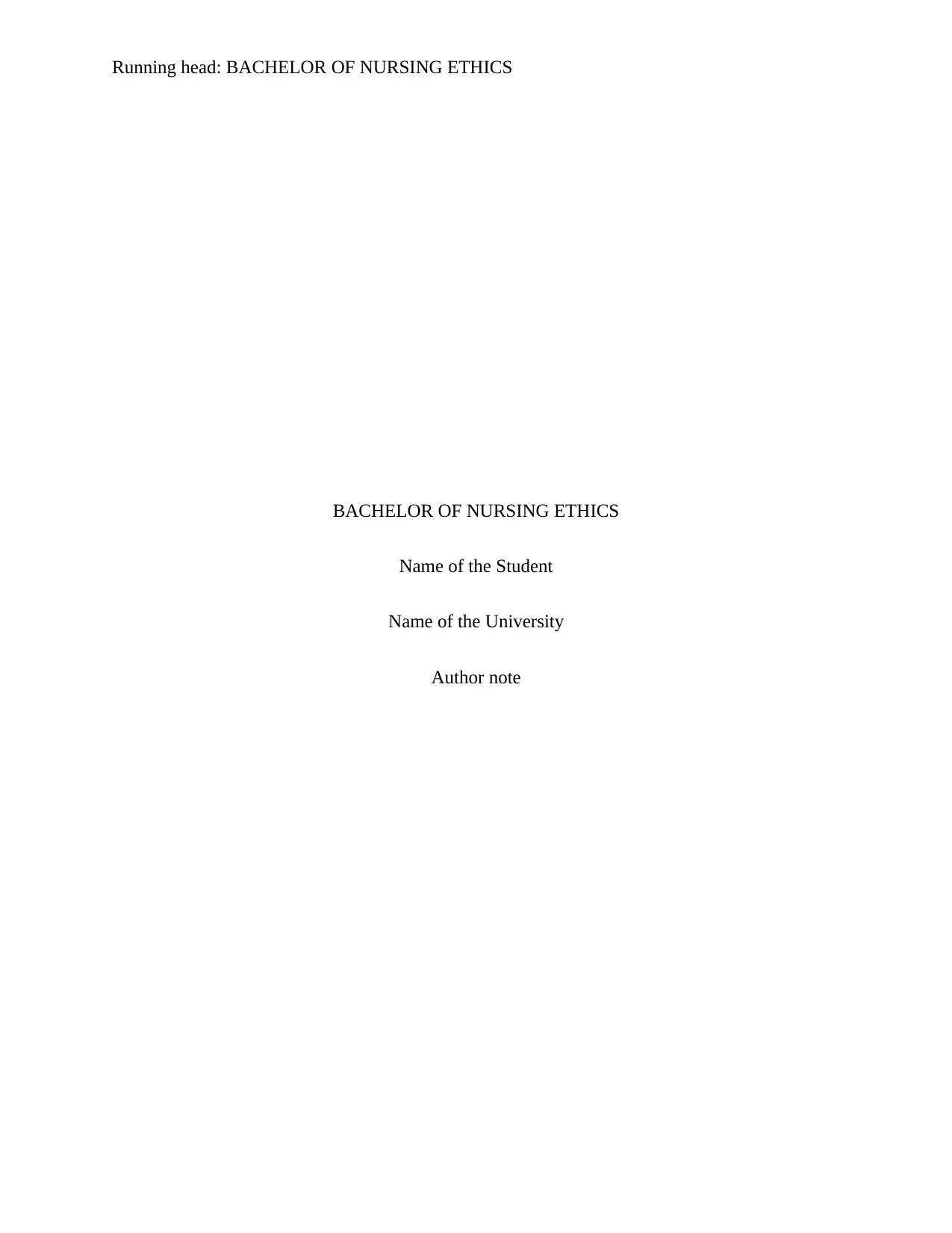
Running head: BACHELOR OF NURSING ETHICS
BACHELOR OF NURSING ETHICS
Name of the Student
Name of the University
Author note
BACHELOR OF NURSING ETHICS
Name of the Student
Name of the University
Author note
Paraphrase This Document
Need a fresh take? Get an instant paraphrase of this document with our AI Paraphraser
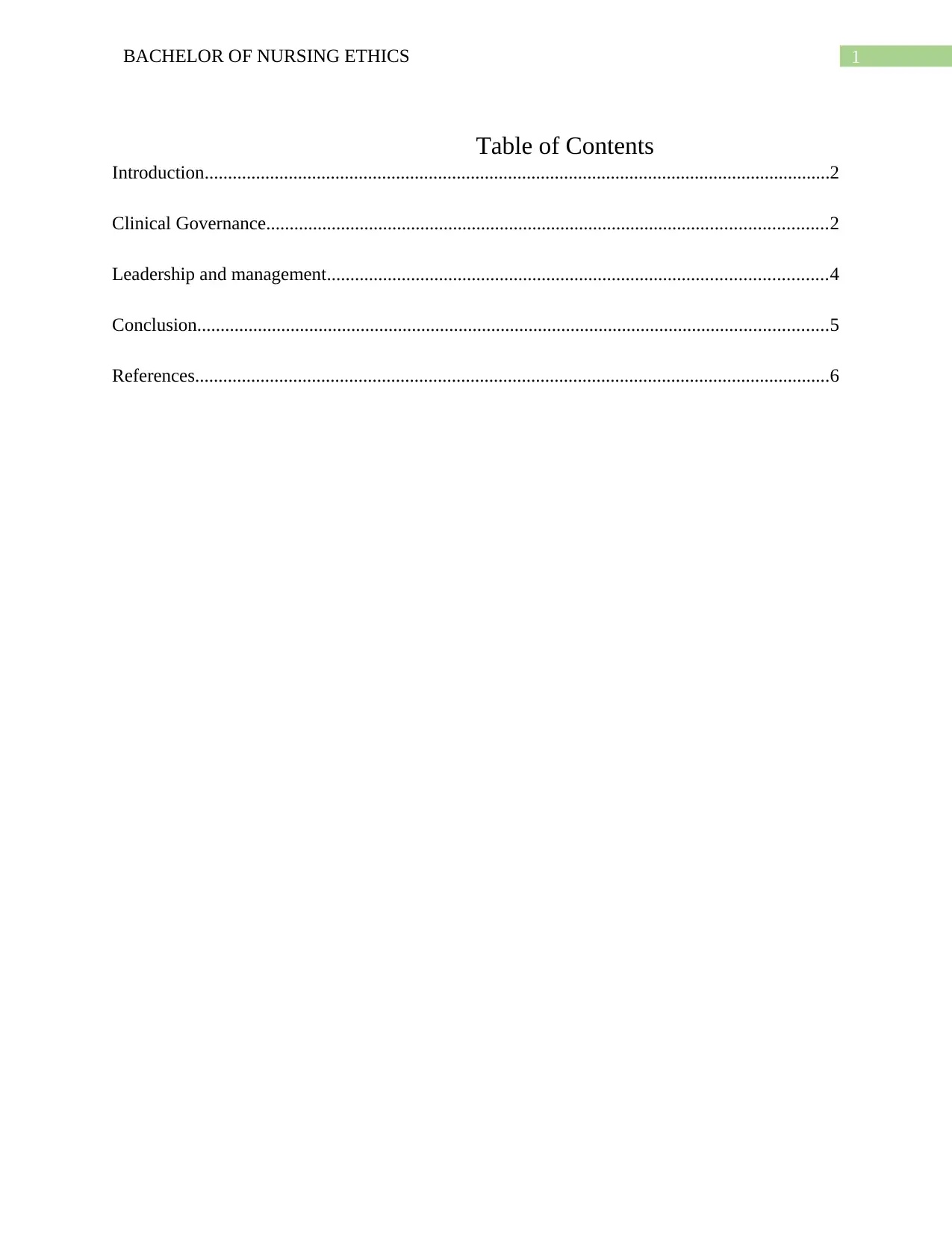
1BACHELOR OF NURSING ETHICS
Table of Contents
Introduction......................................................................................................................................2
Clinical Governance........................................................................................................................2
Leadership and management...........................................................................................................4
Conclusion.......................................................................................................................................5
References........................................................................................................................................6
Table of Contents
Introduction......................................................................................................................................2
Clinical Governance........................................................................................................................2
Leadership and management...........................................................................................................4
Conclusion.......................................................................................................................................5
References........................................................................................................................................6
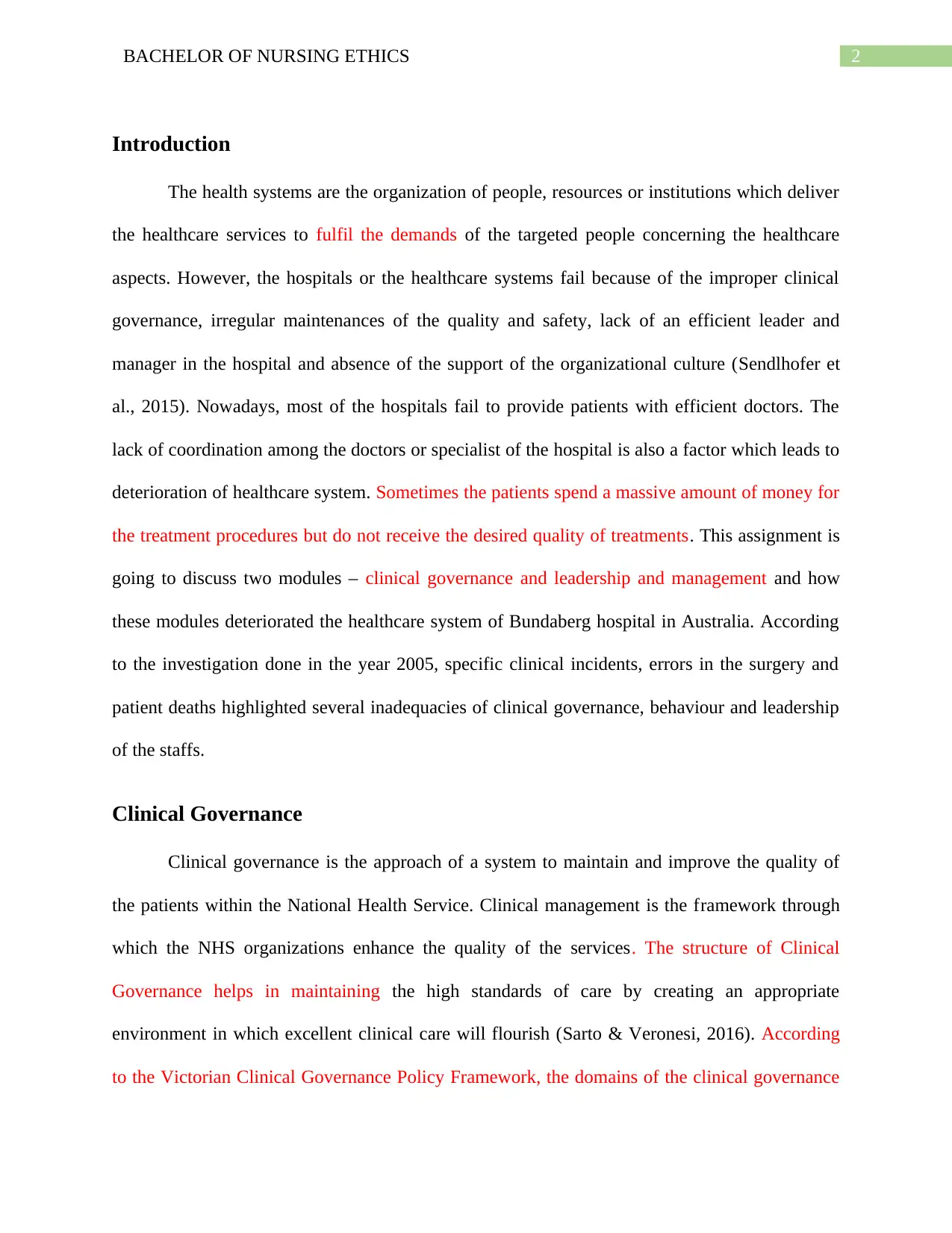
2BACHELOR OF NURSING ETHICS
Introduction
The health systems are the organization of people, resources or institutions which deliver
the healthcare services to fulfil the demands of the targeted people concerning the healthcare
aspects. However, the hospitals or the healthcare systems fail because of the improper clinical
governance, irregular maintenances of the quality and safety, lack of an efficient leader and
manager in the hospital and absence of the support of the organizational culture (Sendlhofer et
al., 2015). Nowadays, most of the hospitals fail to provide patients with efficient doctors. The
lack of coordination among the doctors or specialist of the hospital is also a factor which leads to
deterioration of healthcare system. Sometimes the patients spend a massive amount of money for
the treatment procedures but do not receive the desired quality of treatments. This assignment is
going to discuss two modules – clinical governance and leadership and management and how
these modules deteriorated the healthcare system of Bundaberg hospital in Australia. According
to the investigation done in the year 2005, specific clinical incidents, errors in the surgery and
patient deaths highlighted several inadequacies of clinical governance, behaviour and leadership
of the staffs.
Clinical Governance
Clinical governance is the approach of a system to maintain and improve the quality of
the patients within the National Health Service. Clinical management is the framework through
which the NHS organizations enhance the quality of the services. The structure of Clinical
Governance helps in maintaining the high standards of care by creating an appropriate
environment in which excellent clinical care will flourish (Sarto & Veronesi, 2016). According
to the Victorian Clinical Governance Policy Framework, the domains of the clinical governance
Introduction
The health systems are the organization of people, resources or institutions which deliver
the healthcare services to fulfil the demands of the targeted people concerning the healthcare
aspects. However, the hospitals or the healthcare systems fail because of the improper clinical
governance, irregular maintenances of the quality and safety, lack of an efficient leader and
manager in the hospital and absence of the support of the organizational culture (Sendlhofer et
al., 2015). Nowadays, most of the hospitals fail to provide patients with efficient doctors. The
lack of coordination among the doctors or specialist of the hospital is also a factor which leads to
deterioration of healthcare system. Sometimes the patients spend a massive amount of money for
the treatment procedures but do not receive the desired quality of treatments. This assignment is
going to discuss two modules – clinical governance and leadership and management and how
these modules deteriorated the healthcare system of Bundaberg hospital in Australia. According
to the investigation done in the year 2005, specific clinical incidents, errors in the surgery and
patient deaths highlighted several inadequacies of clinical governance, behaviour and leadership
of the staffs.
Clinical Governance
Clinical governance is the approach of a system to maintain and improve the quality of
the patients within the National Health Service. Clinical management is the framework through
which the NHS organizations enhance the quality of the services. The structure of Clinical
Governance helps in maintaining the high standards of care by creating an appropriate
environment in which excellent clinical care will flourish (Sarto & Veronesi, 2016). According
to the Victorian Clinical Governance Policy Framework, the domains of the clinical governance
⊘ This is a preview!⊘
Do you want full access?
Subscribe today to unlock all pages.

Trusted by 1+ million students worldwide
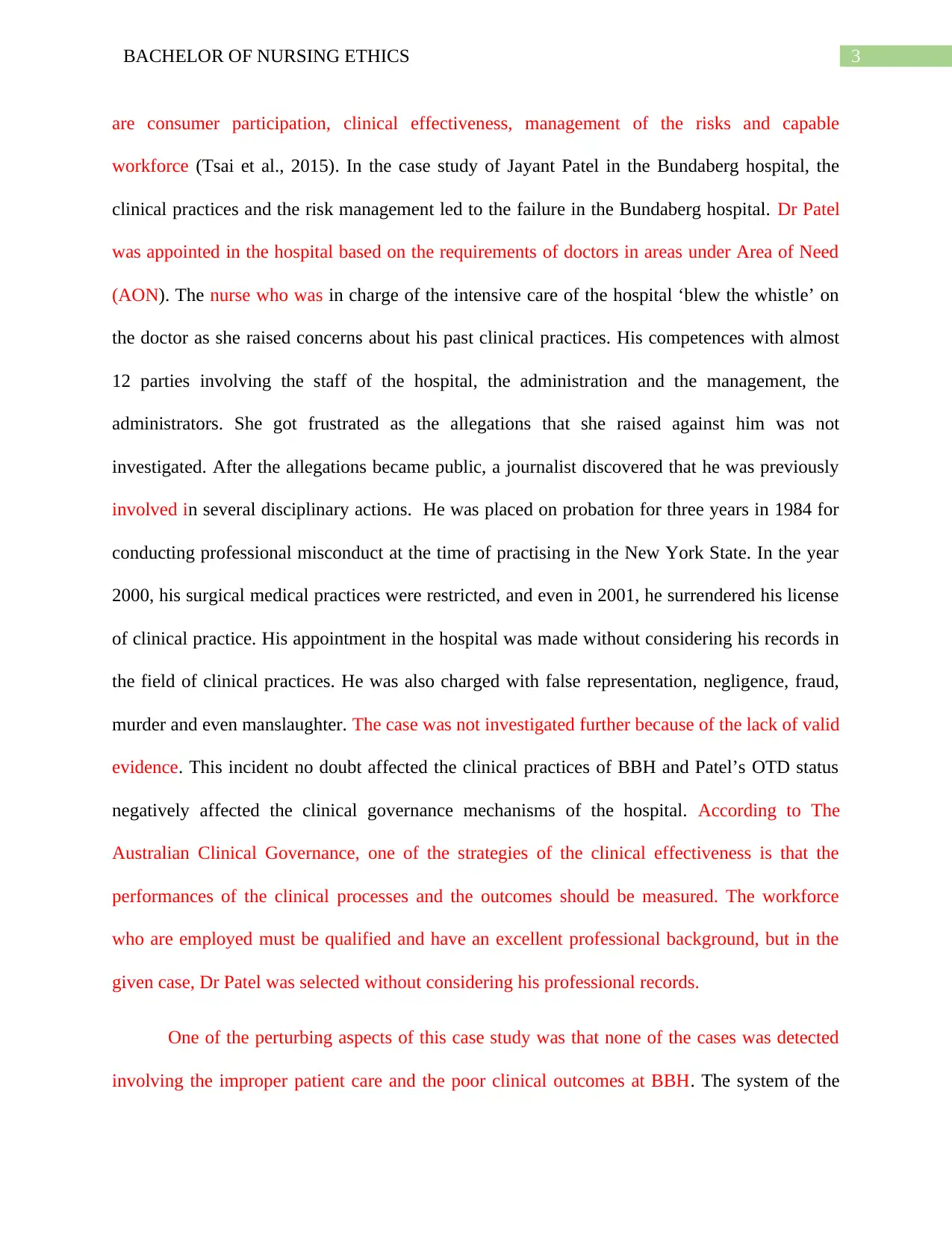
3BACHELOR OF NURSING ETHICS
are consumer participation, clinical effectiveness, management of the risks and capable
workforce (Tsai et al., 2015). In the case study of Jayant Patel in the Bundaberg hospital, the
clinical practices and the risk management led to the failure in the Bundaberg hospital. Dr Patel
was appointed in the hospital based on the requirements of doctors in areas under Area of Need
(AON). The nurse who was in charge of the intensive care of the hospital ‘blew the whistle’ on
the doctor as she raised concerns about his past clinical practices. His competences with almost
12 parties involving the staff of the hospital, the administration and the management, the
administrators. She got frustrated as the allegations that she raised against him was not
investigated. After the allegations became public, a journalist discovered that he was previously
involved in several disciplinary actions. He was placed on probation for three years in 1984 for
conducting professional misconduct at the time of practising in the New York State. In the year
2000, his surgical medical practices were restricted, and even in 2001, he surrendered his license
of clinical practice. His appointment in the hospital was made without considering his records in
the field of clinical practices. He was also charged with false representation, negligence, fraud,
murder and even manslaughter. The case was not investigated further because of the lack of valid
evidence. This incident no doubt affected the clinical practices of BBH and Patel’s OTD status
negatively affected the clinical governance mechanisms of the hospital. According to The
Australian Clinical Governance, one of the strategies of the clinical effectiveness is that the
performances of the clinical processes and the outcomes should be measured. The workforce
who are employed must be qualified and have an excellent professional background, but in the
given case, Dr Patel was selected without considering his professional records.
One of the perturbing aspects of this case study was that none of the cases was detected
involving the improper patient care and the poor clinical outcomes at BBH. The system of the
are consumer participation, clinical effectiveness, management of the risks and capable
workforce (Tsai et al., 2015). In the case study of Jayant Patel in the Bundaberg hospital, the
clinical practices and the risk management led to the failure in the Bundaberg hospital. Dr Patel
was appointed in the hospital based on the requirements of doctors in areas under Area of Need
(AON). The nurse who was in charge of the intensive care of the hospital ‘blew the whistle’ on
the doctor as she raised concerns about his past clinical practices. His competences with almost
12 parties involving the staff of the hospital, the administration and the management, the
administrators. She got frustrated as the allegations that she raised against him was not
investigated. After the allegations became public, a journalist discovered that he was previously
involved in several disciplinary actions. He was placed on probation for three years in 1984 for
conducting professional misconduct at the time of practising in the New York State. In the year
2000, his surgical medical practices were restricted, and even in 2001, he surrendered his license
of clinical practice. His appointment in the hospital was made without considering his records in
the field of clinical practices. He was also charged with false representation, negligence, fraud,
murder and even manslaughter. The case was not investigated further because of the lack of valid
evidence. This incident no doubt affected the clinical practices of BBH and Patel’s OTD status
negatively affected the clinical governance mechanisms of the hospital. According to The
Australian Clinical Governance, one of the strategies of the clinical effectiveness is that the
performances of the clinical processes and the outcomes should be measured. The workforce
who are employed must be qualified and have an excellent professional background, but in the
given case, Dr Patel was selected without considering his professional records.
One of the perturbing aspects of this case study was that none of the cases was detected
involving the improper patient care and the poor clinical outcomes at BBH. The system of the
Paraphrase This Document
Need a fresh take? Get an instant paraphrase of this document with our AI Paraphraser
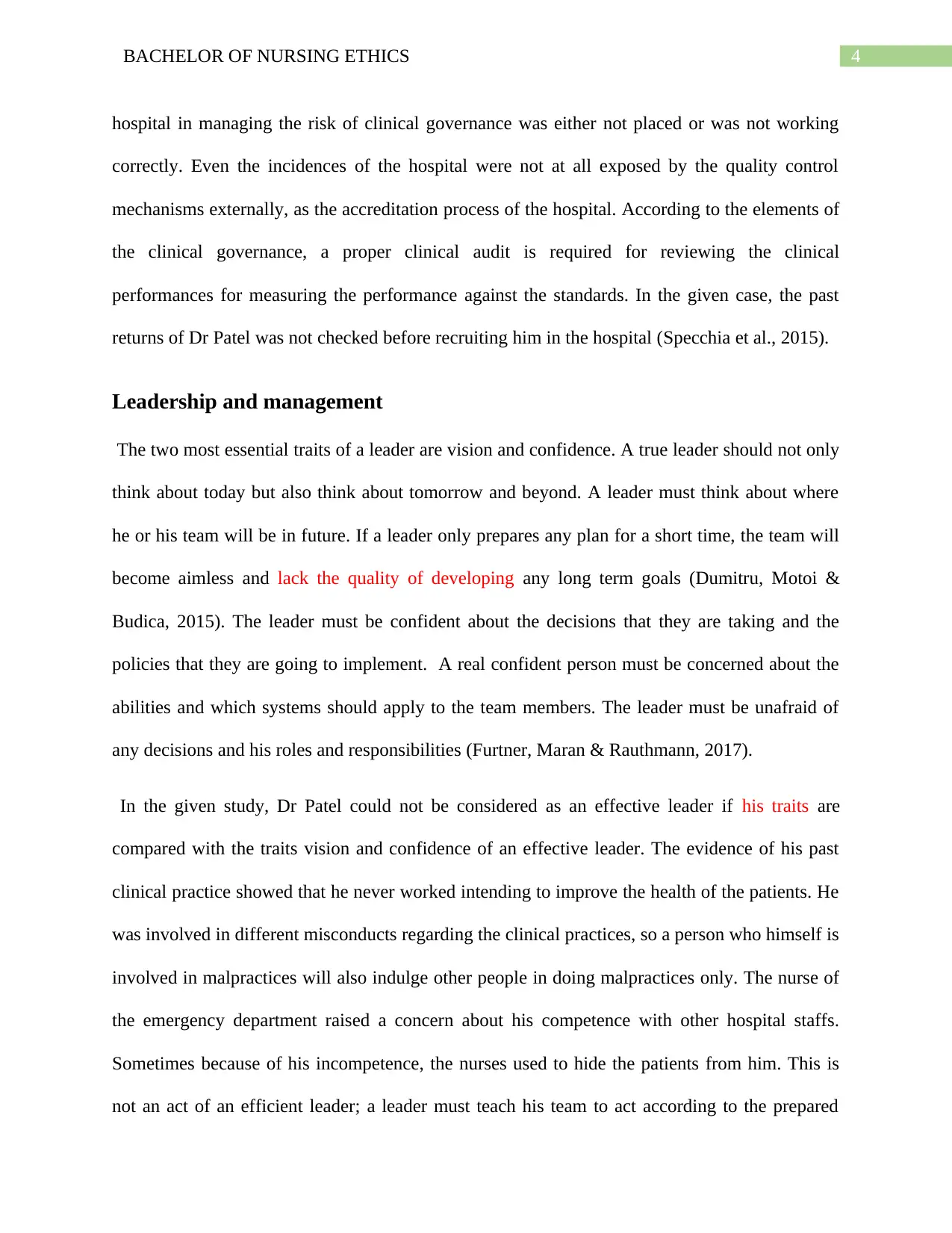
4BACHELOR OF NURSING ETHICS
hospital in managing the risk of clinical governance was either not placed or was not working
correctly. Even the incidences of the hospital were not at all exposed by the quality control
mechanisms externally, as the accreditation process of the hospital. According to the elements of
the clinical governance, a proper clinical audit is required for reviewing the clinical
performances for measuring the performance against the standards. In the given case, the past
returns of Dr Patel was not checked before recruiting him in the hospital (Specchia et al., 2015).
Leadership and management
The two most essential traits of a leader are vision and confidence. A true leader should not only
think about today but also think about tomorrow and beyond. A leader must think about where
he or his team will be in future. If a leader only prepares any plan for a short time, the team will
become aimless and lack the quality of developing any long term goals (Dumitru, Motoi &
Budica, 2015). The leader must be confident about the decisions that they are taking and the
policies that they are going to implement. A real confident person must be concerned about the
abilities and which systems should apply to the team members. The leader must be unafraid of
any decisions and his roles and responsibilities (Furtner, Maran & Rauthmann, 2017).
In the given study, Dr Patel could not be considered as an effective leader if his traits are
compared with the traits vision and confidence of an effective leader. The evidence of his past
clinical practice showed that he never worked intending to improve the health of the patients. He
was involved in different misconducts regarding the clinical practices, so a person who himself is
involved in malpractices will also indulge other people in doing malpractices only. The nurse of
the emergency department raised a concern about his competence with other hospital staffs.
Sometimes because of his incompetence, the nurses used to hide the patients from him. This is
not an act of an efficient leader; a leader must teach his team to act according to the prepared
hospital in managing the risk of clinical governance was either not placed or was not working
correctly. Even the incidences of the hospital were not at all exposed by the quality control
mechanisms externally, as the accreditation process of the hospital. According to the elements of
the clinical governance, a proper clinical audit is required for reviewing the clinical
performances for measuring the performance against the standards. In the given case, the past
returns of Dr Patel was not checked before recruiting him in the hospital (Specchia et al., 2015).
Leadership and management
The two most essential traits of a leader are vision and confidence. A true leader should not only
think about today but also think about tomorrow and beyond. A leader must think about where
he or his team will be in future. If a leader only prepares any plan for a short time, the team will
become aimless and lack the quality of developing any long term goals (Dumitru, Motoi &
Budica, 2015). The leader must be confident about the decisions that they are taking and the
policies that they are going to implement. A real confident person must be concerned about the
abilities and which systems should apply to the team members. The leader must be unafraid of
any decisions and his roles and responsibilities (Furtner, Maran & Rauthmann, 2017).
In the given study, Dr Patel could not be considered as an effective leader if his traits are
compared with the traits vision and confidence of an effective leader. The evidence of his past
clinical practice showed that he never worked intending to improve the health of the patients. He
was involved in different misconducts regarding the clinical practices, so a person who himself is
involved in malpractices will also indulge other people in doing malpractices only. The nurse of
the emergency department raised a concern about his competence with other hospital staffs.
Sometimes because of his incompetence, the nurses used to hide the patients from him. This is
not an act of an efficient leader; a leader must teach his team to act according to the prepared
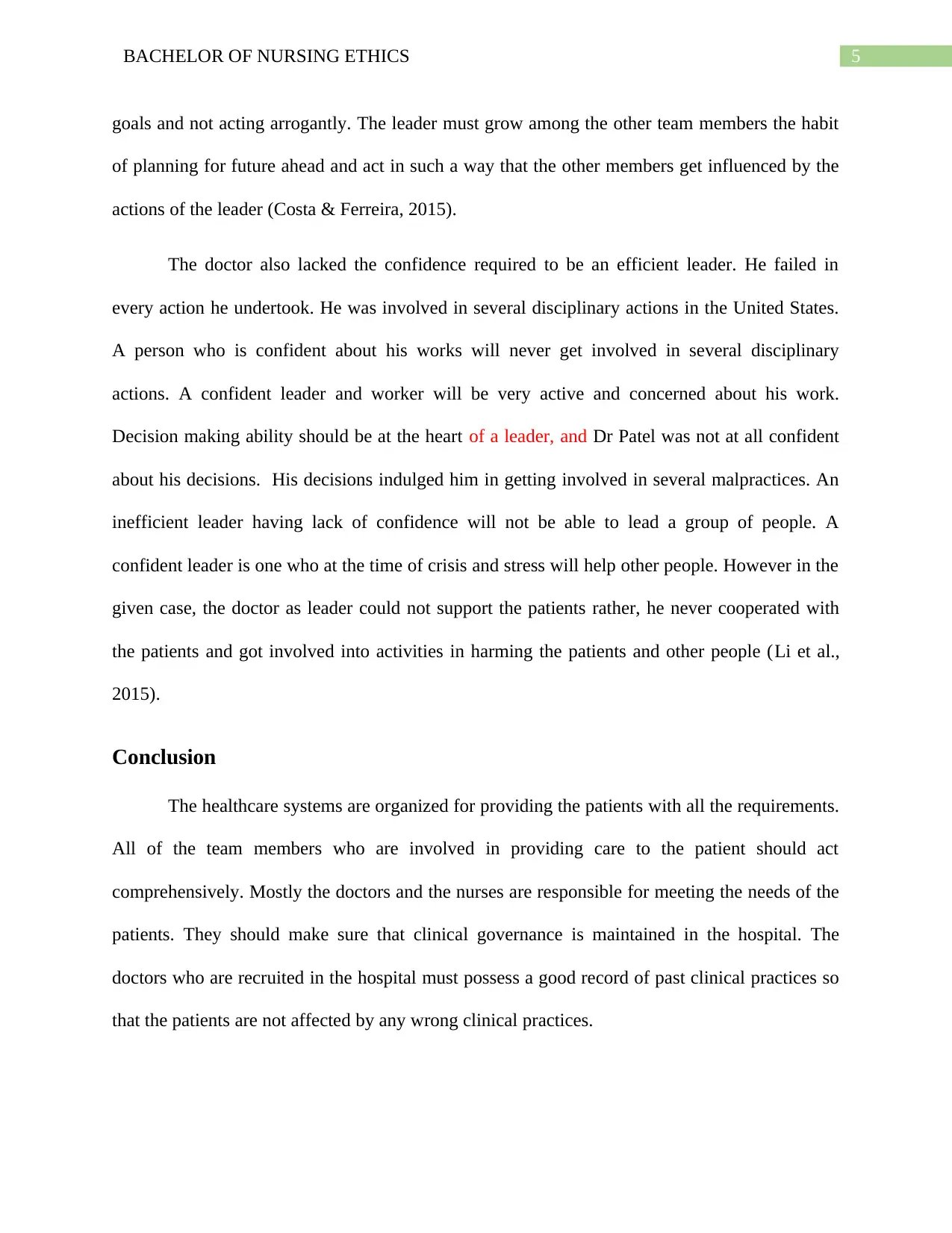
5BACHELOR OF NURSING ETHICS
goals and not acting arrogantly. The leader must grow among the other team members the habit
of planning for future ahead and act in such a way that the other members get influenced by the
actions of the leader (Costa & Ferreira, 2015).
The doctor also lacked the confidence required to be an efficient leader. He failed in
every action he undertook. He was involved in several disciplinary actions in the United States.
A person who is confident about his works will never get involved in several disciplinary
actions. A confident leader and worker will be very active and concerned about his work.
Decision making ability should be at the heart of a leader, and Dr Patel was not at all confident
about his decisions. His decisions indulged him in getting involved in several malpractices. An
inefficient leader having lack of confidence will not be able to lead a group of people. A
confident leader is one who at the time of crisis and stress will help other people. However in the
given case, the doctor as leader could not support the patients rather, he never cooperated with
the patients and got involved into activities in harming the patients and other people (Li et al.,
2015).
Conclusion
The healthcare systems are organized for providing the patients with all the requirements.
All of the team members who are involved in providing care to the patient should act
comprehensively. Mostly the doctors and the nurses are responsible for meeting the needs of the
patients. They should make sure that clinical governance is maintained in the hospital. The
doctors who are recruited in the hospital must possess a good record of past clinical practices so
that the patients are not affected by any wrong clinical practices.
goals and not acting arrogantly. The leader must grow among the other team members the habit
of planning for future ahead and act in such a way that the other members get influenced by the
actions of the leader (Costa & Ferreira, 2015).
The doctor also lacked the confidence required to be an efficient leader. He failed in
every action he undertook. He was involved in several disciplinary actions in the United States.
A person who is confident about his works will never get involved in several disciplinary
actions. A confident leader and worker will be very active and concerned about his work.
Decision making ability should be at the heart of a leader, and Dr Patel was not at all confident
about his decisions. His decisions indulged him in getting involved in several malpractices. An
inefficient leader having lack of confidence will not be able to lead a group of people. A
confident leader is one who at the time of crisis and stress will help other people. However in the
given case, the doctor as leader could not support the patients rather, he never cooperated with
the patients and got involved into activities in harming the patients and other people (Li et al.,
2015).
Conclusion
The healthcare systems are organized for providing the patients with all the requirements.
All of the team members who are involved in providing care to the patient should act
comprehensively. Mostly the doctors and the nurses are responsible for meeting the needs of the
patients. They should make sure that clinical governance is maintained in the hospital. The
doctors who are recruited in the hospital must possess a good record of past clinical practices so
that the patients are not affected by any wrong clinical practices.
⊘ This is a preview!⊘
Do you want full access?
Subscribe today to unlock all pages.

Trusted by 1+ million students worldwide
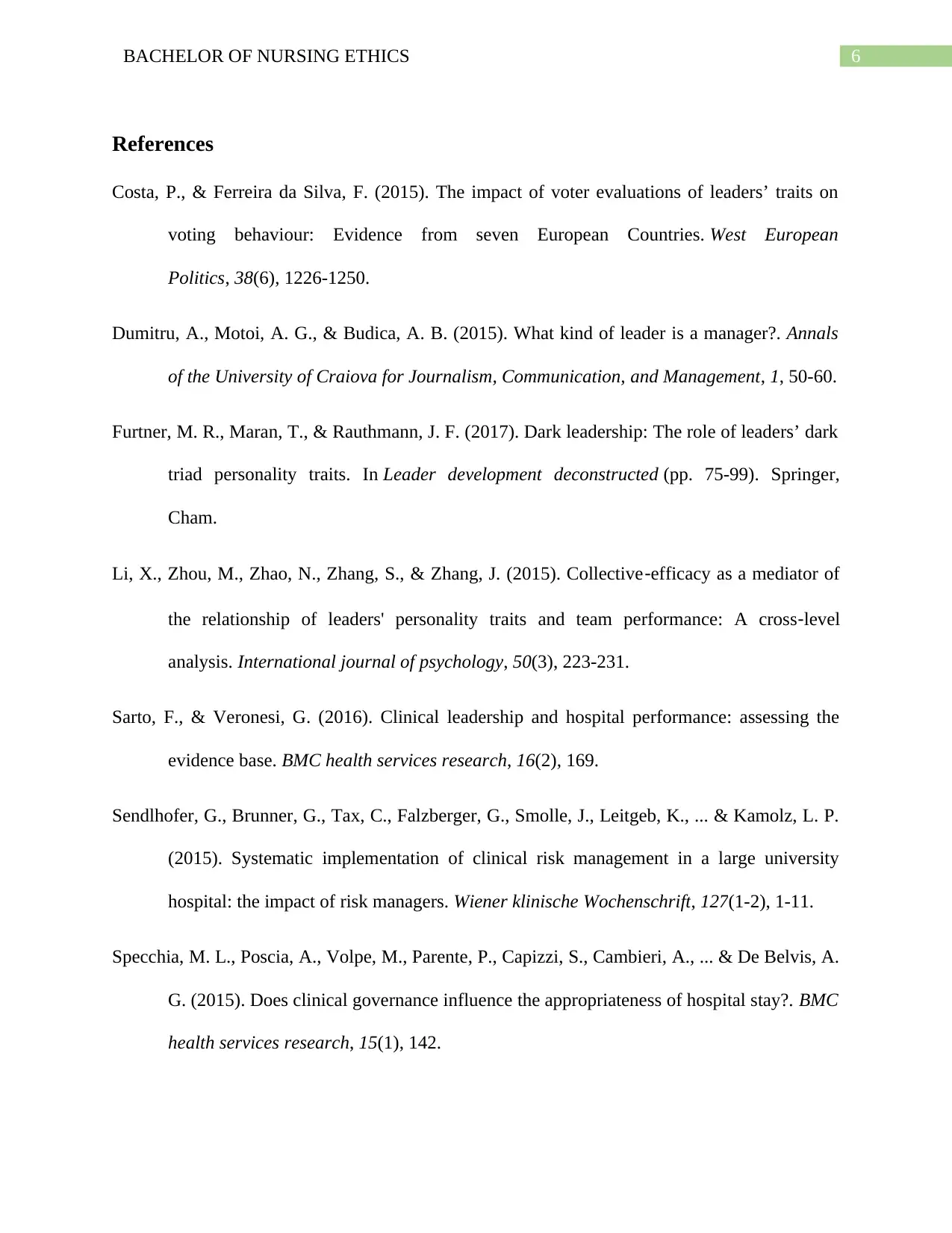
6BACHELOR OF NURSING ETHICS
References
Costa, P., & Ferreira da Silva, F. (2015). The impact of voter evaluations of leaders’ traits on
voting behaviour: Evidence from seven European Countries. West European
Politics, 38(6), 1226-1250.
Dumitru, A., Motoi, A. G., & Budica, A. B. (2015). What kind of leader is a manager?. Annals
of the University of Craiova for Journalism, Communication, and Management, 1, 50-60.
Furtner, M. R., Maran, T., & Rauthmann, J. F. (2017). Dark leadership: The role of leaders’ dark
triad personality traits. In Leader development deconstructed (pp. 75-99). Springer,
Cham.
Li, X., Zhou, M., Zhao, N., Zhang, S., & Zhang, J. (2015). Collective‐efficacy as a mediator of
the relationship of leaders' personality traits and team performance: A cross‐level
analysis. International journal of psychology, 50(3), 223-231.
Sarto, F., & Veronesi, G. (2016). Clinical leadership and hospital performance: assessing the
evidence base. BMC health services research, 16(2), 169.
Sendlhofer, G., Brunner, G., Tax, C., Falzberger, G., Smolle, J., Leitgeb, K., ... & Kamolz, L. P.
(2015). Systematic implementation of clinical risk management in a large university
hospital: the impact of risk managers. Wiener klinische Wochenschrift, 127(1-2), 1-11.
Specchia, M. L., Poscia, A., Volpe, M., Parente, P., Capizzi, S., Cambieri, A., ... & De Belvis, A.
G. (2015). Does clinical governance influence the appropriateness of hospital stay?. BMC
health services research, 15(1), 142.
References
Costa, P., & Ferreira da Silva, F. (2015). The impact of voter evaluations of leaders’ traits on
voting behaviour: Evidence from seven European Countries. West European
Politics, 38(6), 1226-1250.
Dumitru, A., Motoi, A. G., & Budica, A. B. (2015). What kind of leader is a manager?. Annals
of the University of Craiova for Journalism, Communication, and Management, 1, 50-60.
Furtner, M. R., Maran, T., & Rauthmann, J. F. (2017). Dark leadership: The role of leaders’ dark
triad personality traits. In Leader development deconstructed (pp. 75-99). Springer,
Cham.
Li, X., Zhou, M., Zhao, N., Zhang, S., & Zhang, J. (2015). Collective‐efficacy as a mediator of
the relationship of leaders' personality traits and team performance: A cross‐level
analysis. International journal of psychology, 50(3), 223-231.
Sarto, F., & Veronesi, G. (2016). Clinical leadership and hospital performance: assessing the
evidence base. BMC health services research, 16(2), 169.
Sendlhofer, G., Brunner, G., Tax, C., Falzberger, G., Smolle, J., Leitgeb, K., ... & Kamolz, L. P.
(2015). Systematic implementation of clinical risk management in a large university
hospital: the impact of risk managers. Wiener klinische Wochenschrift, 127(1-2), 1-11.
Specchia, M. L., Poscia, A., Volpe, M., Parente, P., Capizzi, S., Cambieri, A., ... & De Belvis, A.
G. (2015). Does clinical governance influence the appropriateness of hospital stay?. BMC
health services research, 15(1), 142.
Paraphrase This Document
Need a fresh take? Get an instant paraphrase of this document with our AI Paraphraser
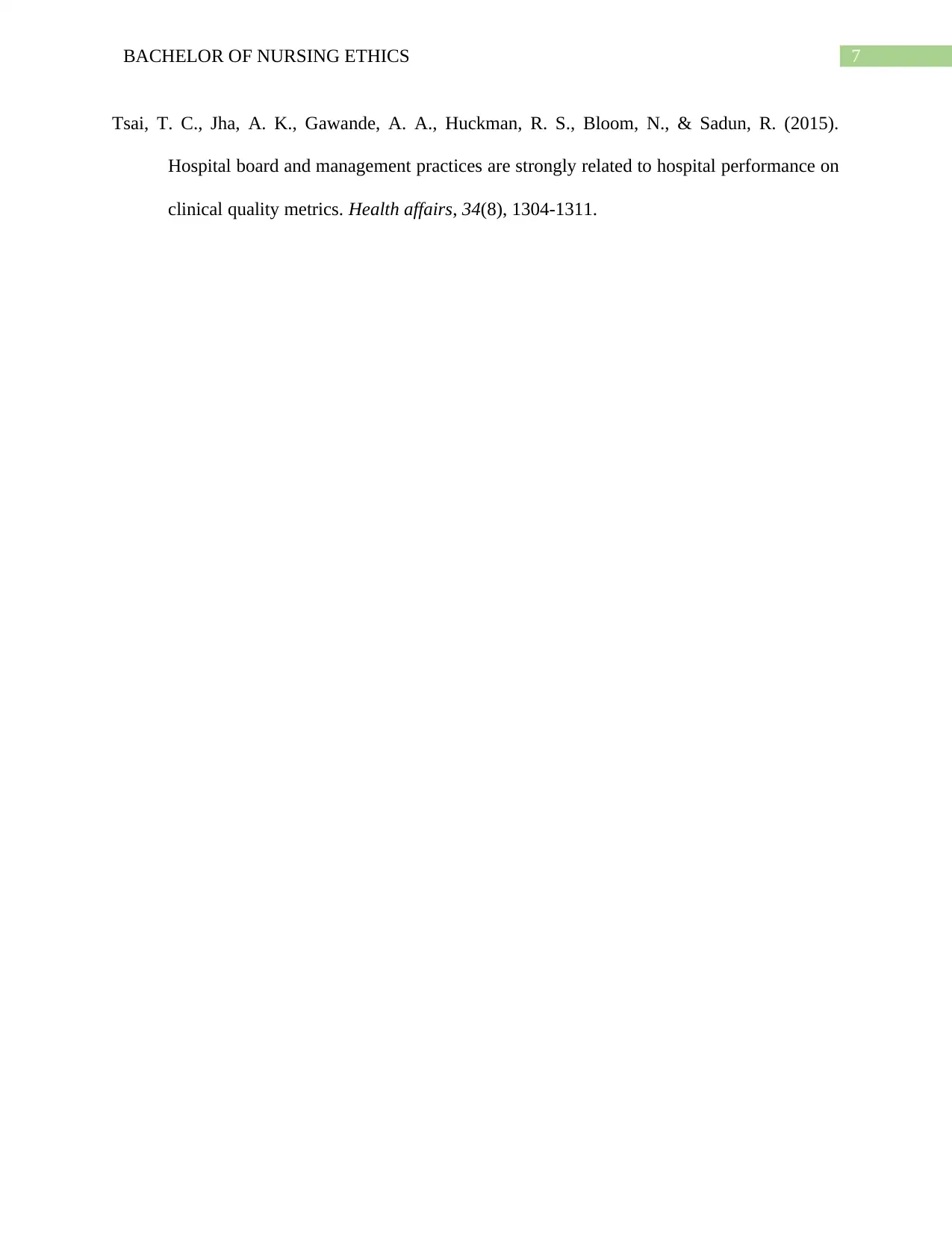
7BACHELOR OF NURSING ETHICS
Tsai, T. C., Jha, A. K., Gawande, A. A., Huckman, R. S., Bloom, N., & Sadun, R. (2015).
Hospital board and management practices are strongly related to hospital performance on
clinical quality metrics. Health affairs, 34(8), 1304-1311.
Tsai, T. C., Jha, A. K., Gawande, A. A., Huckman, R. S., Bloom, N., & Sadun, R. (2015).
Hospital board and management practices are strongly related to hospital performance on
clinical quality metrics. Health affairs, 34(8), 1304-1311.
1 out of 8
Related Documents
Your All-in-One AI-Powered Toolkit for Academic Success.
+13062052269
info@desklib.com
Available 24*7 on WhatsApp / Email
![[object Object]](/_next/static/media/star-bottom.7253800d.svg)
Unlock your academic potential
Copyright © 2020–2025 A2Z Services. All Rights Reserved. Developed and managed by ZUCOL.




